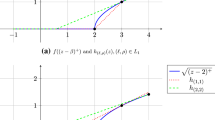Abstract
The basic urn problem is to determine the probability of drawing one colored ball from an urn with known composition of differently colored balls. If the composition is unknown, then it is called uncertain. This paper designs some uncertain urn problems in order to compare probability theory and uncertainty theory. It is concluded that uncertainty theory is better than probability theory to deal with uncertain urn problems. As a by-product, this paper also solves the choice problem in Ellsberg experiment by chance theory.

Similar content being viewed by others
References
Ellsberg D (1961) Risk, ambiguity, and the Savage axioms. Quarterly Journal of Economics. 75(4):643–669
Fox CR, Tversky A (1995) Ambiguity aversion and comparative ignorance. Quarterly Journal of Economics. 110(3):585–603
Hou Y.C. (2014). Subadditivity of chance measure. Journal of Uncertainty Analysis and Applications. 2, Article 14
Kolmogorov AN (1933) Grundbegriffe der Wahrscheinlichkeitsrechnung. Julius Springer, Berlin
Liu B (2007) Uncertainty Theory, 2nd edn. Springer-Verlag, Berlin
Liu B (2009) Some research problems in uncertainty theory. Journal of Uncertain Systems. 3(1):3–10
Liu B (2010) Uncertainty Theory: A Branch of Mathematics for Modeling Human Uncertainty. Springer-Verlag, Berlin
Liu YH (2013a) Uncertain random variables: A mixture of uncertainty and randomness. Soft Computing. 17(4):625–634
Liu YH (2013b) Uncertain random programming with applications. Fuzzy Optimization and Decision Making. 12(2):153–169
Segal U (1987) The Ellsberg paradox and risk aversion: An anticipated utility approach. International Economic Review. 28(1):175–202
Yao K, Gao J (2016) Law of large numbers for uncertain random variables. IEEE Transactions on Fuzzy Systems. 24(3):615–621
Funding
This work was supported by National Natural Science Foundation of China Grant No. 61573210.
Author information
Authors and Affiliations
Corresponding author
Ethics declarations
Conflict of interest
The authors declare that there is no conflict of interest regarding the publication of this paper.
Ethical Approval
This article does not contain any studies with human participants performed by any of the authors.
Additional information
Communicated by V. Loia.
Publisher's Note
Springer Nature remains neutral with regard to jurisdictional claims in published maps and institutional affiliations.
Rights and permissions
About this article
Cite this article
Liu, B. Uncertain Urn Problems and Ellsberg Experiment. Soft Comput 23, 6579–6584 (2019). https://doi.org/10.1007/s00500-018-3306-7
Published:
Issue Date:
DOI: https://doi.org/10.1007/s00500-018-3306-7




